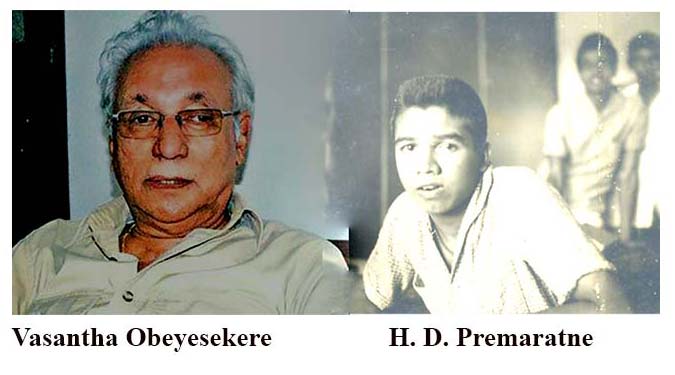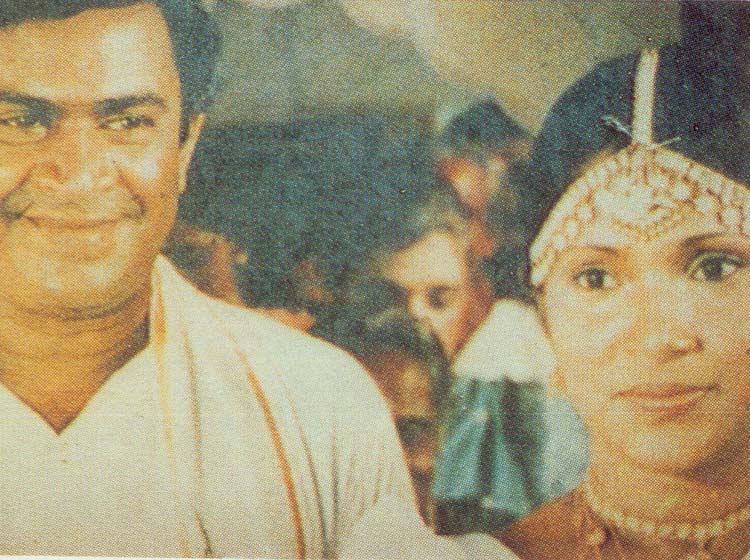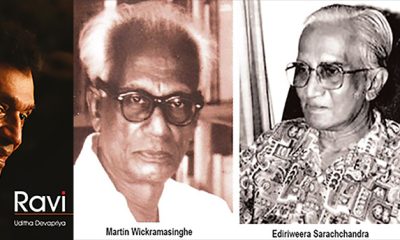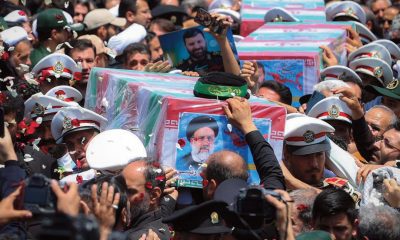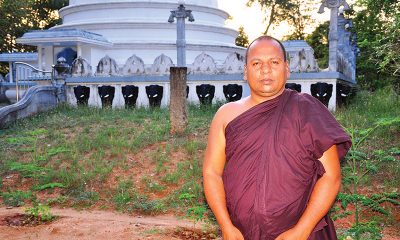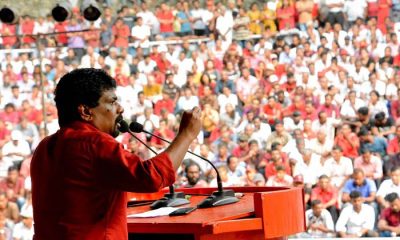Features
“Dadayama” and the Sinhala middle – cinema
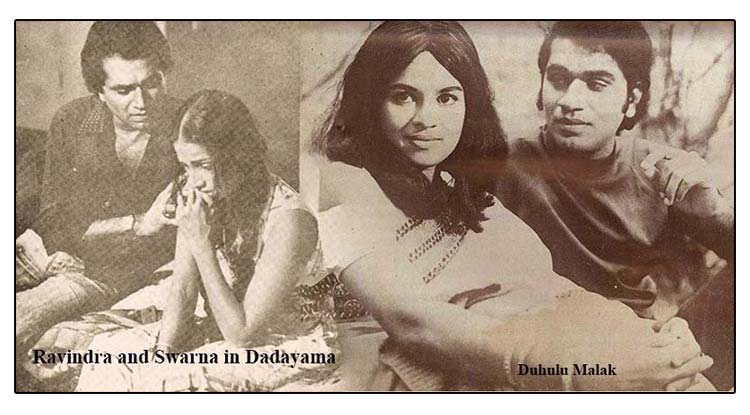
By Uditha Devapriya
In a long, thoughtful article on Vasantha Obeyesekere in the Daily Mirror two years ago (“Versatile Filmmaker Vasantha Obeysekera’s Dadayama“, August 6, 2022), D. B. S. Jeyaraj remembers going to watch Dadayama with Ajith Samaranayake for the first time. This was 1983, a few months before the riots; political turmoil had become a fact of life, but people went in large numbers to theatres. Dadayama was no exception.
“When we went to the Regal Theatre, the show had already started running to a full house. Furthermore, tickets to the next show were also sold out. There were long lineups of ticket holders waiting to see the next show of the film. The chances of seeing the film that evening or night were extremely remote.”
The most obvious reason for the full and packed audiences, of course, was the experience Obeyesekere’s film had offered spectators. In the context of the Sri Lankan cinema, there had not been a film like it before. It represented not only the peak of the Sinhala cinema of the 1980s, but as importantly, the high point of the middlebrow-masscult culture of that decade. By now, the divide between box-office success and critical appeal that had prevailed and, in a way, defined the cinema in the 1960s and 1970s had faded away. What was once considered as lowbrow entertainment had become middlebrow art. The old middlebrow, by contrast, had become the new highbrow.
Against this backdrop, what Vasantha Obeyesekere did was to subvert the tropes of popular cinema, using the motifs of the mainstream as a vehicle for serious themes. Obeyesekere figured in among a group of ambitious filmmakers – among them, H. D. Premaratne and Vijaya Dharma Sri – who had emerged in the 1970s thanks to the policies of the National Film Corporation, and had taken it on themselves to question the conventions and frontiers of their medium. In doing so, they carved a space for themselves.
Dadayama was far from the first film that exemplified this trend. Nor was it Obeyesekere’s first work to take a step in that direction. Before Dadayama, he made Palagetiyo. And before Palagetiyo, he made Diyamanthi, a slick neo-Hitchcockian thriller which steered clear of the song-and-dance sequences of mainstream Sinhala films, yet, somehow, managed to keep audiences entertained. Diyamanthi, in turn, followed a long line of films that began with H. D. Premaratne’s Sikuruliya and Apeksha, and Vijaya Dharma Sri’s Duhulu Malak.
For all intents and purposes, these were films that examined “serious” themes, political or otherwise. Yet they did so while featuring some of the most melodramatic, contrived storylines that could ever be concocted. Sikuruliya, for instance, borrows its plot from the Ummagga Jatakaya and every other trope of Sinhala romance films. Yet, crucially, it subverts those tropes. In a typical Sinhala film, the forlorn girl – played here by the highly versatile Swineetha Weerasinghe – would not take it upon herself to elope with another man on the day of her wedding: she would invariably wait for someone to rescue her. Yet here, she does what she pleases with various men who enter her life.
Apeksha takes this a step ahead by confronting social class, a theme that had never been addressed with any modicum of intelligence in a mainstream Sinhala film. In popular Sinhala cinema, class served as a backdrop, or at best a prop. The rich man would invariably be the villain, the poor boy the hero, and the (almost always rich) girl would be saved by the latter from the clutches of the former. Apeksha ends on that note: it culminates in a predictable fistfight between hero and villain. But the rich, depraved villain does not entirely become a villain: at certain points, such as when he visits a singer at a bar he has fallen in love with, we feel the director is trying to humanise him.
Vijaya Dharma Sri’s Duhulu Malak tackles a more controversial and difficult theme: adultery. As the film scholar Laleen Jayamanne notes, Duhulu Malak became “perhaps the first Sri Lankan film to present adultery in a manner that makes it seem visually pleasurable.” This was no mean achievement, and it cannot be undermined. However, Dharma Sri worked at a time when adultery could not be presented in any visually pleasing way without making concessions to the box-office. For that reason, Duhulu Malak has the cake and eats it too: it sympathises with the woman who faces a stark choice between her husband and her lover, yet satisfies the moral brigade by making her return to her husband.
Both Premaratne and Dharma Sri spent the rest of their careers making films that addressed one difficult theme after another, within an essentially commercial framework. To their credit, this formula never backfired on them. Premaratne, for one, managed to make a series of hits in the most unlikely and impossible settings.
Two of his films, Devani Gamana and Palama Yata, were released in that interregnum between the ethnic riots and the second JVP insurrection. Both performed well at the box-office. Then, in 1997, when the trauma of the insurrection had begun to fade away, he made Visidela, which confronted the insurgency as in unfolds in an otherwise quaint, nondescript Sinhala village.
It is against this backdrop that one should note Obeyesekere’s achievement. Obeyesekere fundamentally belongs to the middle-cinema space, but his films are not of the same mould as Premaratne’s and Dharma Sri’s. Premaratne and Dharma Sri ostensibly steered clear of political themes, though of course one can argue that there is nothing apolitical about the themes they explored.
Obeyesekere, however, is more of a political radical: he questions norms and conventions by first making us idealise them before shattering all illusions we have of them. In this regard, his treatment of class in Palagetiyo is different to Premaratne’s approach to it in Apeksha: unlike the latter, in which the two lovers reconcile, in Palagetiyo the romance eventually takes second place to the harsh realities of class.
As I mentioned earlier, Dadayama was far from the first film which epitomised the middle-cinema space of the 1970s and 1980s. Yet it was unprecedented in its own way. For the first time in a Sinhala film, we are seeing tropes of the popular cinema being presented before our eyes, only to be shattered like the shards of glass that rain down on the camera and the screen in that final encounter between the protagonist and antagonist.
Obeyesekere made sure to include his actors in this scheme. To give the best example, he conjures Irangani Serasinghe out of the blue, presents her as the sweet, idealised mother-type so strongly associated with her, and then destroys that image of her by making her a chain-smoking brothel owner. During a conversation I had with her 10 years ago, Serasinghe recalled being showered by letters from outraged fans: “They all asked me, ‘Why did you take on that role, why did you set such a bad example for our children?’” She seemed visibly distraught. Obeyesekere’s ruse had worked.
It goes without saying that Vasantha Obeyesekere never again reached the heights he did with Dadayama. Kadapathaka Chaya comes a close second, but it is too long, and at one level derivative of Dadayama, to rise on its own. His last great work, Dorakada Marawa, bears comparisons with Dadayama and Palagetiyo. Yet by the time of its release, the Sinhala cinema had moved on to its next phase, marked by the entry of a new and different – a more politically inclined – generation of directors. Premaratne and Dharma Sri continued to make films. Yet they had to give way to a new order.
For better or worse, the Sinhala middle-cinema of the 1970s and 1980s no longer exists. Most of its best and brightest purveyors, including not just Obeyesekere, Dharma Sri, and Premaratne, but also to a considerable extent Sumitra Peries, have long passed away. Yet in that interregnum, that middle-cinema space provided both directors and audiences a chance to confront, address – and even resolve – some of the more pressing issues from that time.
One wonders whether the present culture in Sri Lanka – with its emphasis on low budgets, on avant-gardism, on lavish funding – has made us less appreciative of the cinema’s potential to raise awareness of important issues within mainstream audiences.
Perhaps what we need to do is to return to that earlier mode of filmmaking. In doing so, we can redefine, even revolutionise, the Sinhala cinema, tapping into its potential as the most popular and the most populist of the arts in this country. Films are, essentially, communal experiences. What the likes of Premaratne and Obeyesekere taught us is that this does not preclude directors from examining serious themes, and that mass audiences can be made to respond to them – as the 1970s and 1980s illustrated well enough.
Uditha Devapriya is a writer, researcher, and analyst based in Sri Lanka who contributes to a number of publications on topics such as history, art and culture, politics, and foreign policy. He can be reached at .
Features
The heart-friendly health minister

by Dr Gotabhya Ranasinghe
Senior Consultant Cardiologist
National Hospital Sri Lanka
When we sought a meeting with Hon Dr. Ramesh Pathirana, Minister of Health, he graciously cleared his busy schedule to accommodate us. Renowned for his attentive listening and deep understanding, Minister Pathirana is dedicated to advancing the health sector. His openness and transparency exemplify the qualities of an exemplary politician and minister.
Dr. Palitha Mahipala, the current Health Secretary, demonstrates both commendable enthusiasm and unwavering support. This combination of attributes makes him a highly compatible colleague for the esteemed Minister of Health.
Our discussion centered on a project that has been in the works for the past 30 years, one that no other minister had managed to advance.
Minister Pathirana, however, recognized the project’s significance and its potential to revolutionize care for heart patients.
The project involves the construction of a state-of-the-art facility at the premises of the National Hospital Colombo. The project’s location within the premises of the National Hospital underscores its importance and relevance to the healthcare infrastructure of the nation.
This facility will include a cardiology building and a tertiary care center, equipped with the latest technology to handle and treat all types of heart-related conditions and surgeries.
Securing funding was a major milestone for this initiative. Minister Pathirana successfully obtained approval for a $40 billion loan from the Asian Development Bank. With the funding in place, the foundation stone is scheduled to be laid in September this year, and construction will begin in January 2025.
This project guarantees a consistent and uninterrupted supply of stents and related medications for heart patients. As a result, patients will have timely access to essential medical supplies during their treatment and recovery. By securing these critical resources, the project aims to enhance patient outcomes, minimize treatment delays, and maintain the highest standards of cardiac care.
Upon its fruition, this monumental building will serve as a beacon of hope and healing, symbolizing the unwavering dedication to improving patient outcomes and fostering a healthier society.We anticipate a future marked by significant progress and positive outcomes in Sri Lanka’s cardiovascular treatment landscape within the foreseeable timeframe.
Features
A LOVING TRIBUTE TO JESUIT FR. ALOYSIUS PIERIS ON HIS 90th BIRTHDAY

by Fr. Emmanuel Fernando, OMI
Jesuit Fr. Aloysius Pieris (affectionately called Fr. Aloy) celebrated his 90th birthday on April 9, 2024 and I, as the editor of our Oblate Journal, THE MISSIONARY OBLATE had gone to press by that time. Immediately I decided to publish an article, appreciating the untiring selfless services he continues to offer for inter-Faith dialogue, the renewal of the Catholic Church, his concern for the poor and the suffering Sri Lankan masses and to me, the present writer.
It was in 1988, when I was appointed Director of the Oblate Scholastics at Ampitiya by the then Oblate Provincial Fr. Anselm Silva, that I came to know Fr. Aloy more closely. Knowing well his expertise in matters spiritual, theological, Indological and pastoral, and with the collaborative spirit of my companion-formators, our Oblate Scholastics were sent to Tulana, the Research and Encounter Centre, Kelaniya, of which he is the Founder-Director, for ‘exposure-programmes’ on matters spiritual, biblical, theological and pastoral. Some of these dimensions according to my view and that of my companion-formators, were not available at the National Seminary, Ampitiya.
Ever since that time, our Oblate formators/ accompaniers at the Oblate Scholasticate, Ampitiya , have continued to send our Oblate Scholastics to Tulana Centre for deepening their insights and convictions regarding matters needed to serve the people in today’s context. Fr. Aloy also had tried very enthusiastically with the Oblate team headed by Frs. Oswald Firth and Clement Waidyasekara to begin a Theologate, directed by the Religious Congregations in Sri Lanka, for the contextual formation/ accompaniment of their members. It should very well be a desired goal of the Leaders / Provincials of the Religious Congregations.
Besides being a formator/accompanier at the Oblate Scholasticate, I was entrusted also with the task of editing and publishing our Oblate journal, ‘The Missionary Oblate’. To maintain the quality of the journal I continue to depend on Fr. Aloy for his thought-provoking and stimulating articles on Biblical Spirituality, Biblical Theology and Ecclesiology. I am very grateful to him for his generous assistance. Of late, his writings on renewal of the Church, initiated by Pope St. John XX111 and continued by Pope Francis through the Synodal path, published in our Oblate journal, enable our readers to focus their attention also on the needed renewal in the Catholic Church in Sri Lanka. Fr. Aloy appreciated very much the Synodal path adopted by the Jesuit Pope Francis for the renewal of the Church, rooted very much on prayerful discernment. In my Religious and presbyteral life, Fr.Aloy continues to be my spiritual animator / guide and ongoing formator / acccompanier.
Fr. Aloysius Pieris, BA Hons (Lond), LPh (SHC, India), STL (PFT, Naples), PhD (SLU/VC), ThD (Tilburg), D.Ltt (KU), has been one of the eminent Asian theologians well recognized internationally and one who has lectured and held visiting chairs in many universities both in the West and in the East. Many members of Religious Congregations from Asian countries have benefited from his lectures and guidance in the East Asian Pastoral Institute (EAPI) in Manila, Philippines. He had been a Theologian consulted by the Federation of Asian Bishops’ Conferences for many years. During his professorship at the Gregorian University in Rome, he was called to be a member of a special group of advisers on other religions consulted by Pope Paul VI.
Fr. Aloy is the author of more than 30 books and well over 500 Research Papers. Some of his books and articles have been translated and published in several countries. Among those books, one can find the following: 1) The Genesis of an Asian Theology of Liberation (An Autobiographical Excursus on the Art of Theologising in Asia, 2) An Asian Theology of Liberation, 3) Providential Timeliness of Vatican 11 (a long-overdue halt to a scandalous millennium, 4) Give Vatican 11 a chance, 5) Leadership in the Church, 6) Relishing our faith in working for justice (Themes for study and discussion), 7) A Message meant mainly, not exclusively for Jesuits (Background information necessary for helping Francis renew the Church), 8) Lent in Lanka (Reflections and Resolutions, 9) Love meets wisdom (A Christian Experience of Buddhism, 10) Fire and Water 11) God’s Reign for God’s poor, 12) Our Unhiddden Agenda (How we Jesuits work, pray and form our men). He is also the Editor of two journals, Vagdevi, Journal of Religious Reflection and Dialogue, New Series.
Fr. Aloy has a BA in Pali and Sanskrit from the University of London and a Ph.D in Buddhist Philosophy from the University of Sri Lankan, Vidyodaya Campus. On Nov. 23, 2019, he was awarded the prestigious honorary Doctorate of Literature (D.Litt) by the Chancellor of the University of Kelaniya, the Most Venerable Welamitiyawe Dharmakirthi Sri Kusala Dhamma Thera.
Fr. Aloy continues to be a promoter of Gospel values and virtues. Justice as a constitutive dimension of love and social concern for the downtrodden masses are very much noted in his life and work. He had very much appreciated the commitment of the late Fr. Joseph (Joe) Fernando, the National Director of the Social and Economic Centre (SEDEC) for the poor.
In Sri Lanka, a few religious Congregations – the Good Shepherd Sisters, the Christian Brothers, the Marist Brothers and the Oblates – have invited him to animate their members especially during their Provincial Congresses, Chapters and International Conferences. The mainline Christian Churches also have sought his advice and followed his seminars. I, for one, regret very much, that the Sri Lankan authorities of the Catholic Church –today’s Hierarchy—- have not sought Fr.
Aloy’s expertise for the renewal of the Catholic Church in Sri Lanka and thus have not benefited from the immense store of wisdom and insight that he can offer to our local Church while the Sri Lankan bishops who governed the Catholic church in the immediate aftermath of the Second Vatican Council (Edmund Fernando OMI, Anthony de Saram, Leo Nanayakkara OSB, Frank Marcus Fernando, Paul Perera,) visited him and consulted him on many matters. Among the Tamil Bishops, Bishop Rayappu Joseph was keeping close contact with him and Bishop J. Deogupillai hosted him and his team visiting him after the horrible Black July massacre of Tamils.
Features
A fairy tale, success or debacle

Sri Lanka-Singapore Free Trade Agreement
By Gomi Senadhira
senadhiragomi@gmail.com
“You might tell fairy tales, but the progress of a country cannot be achieved through such narratives. A country cannot be developed by making false promises. The country moved backward because of the electoral promises made by political parties throughout time. We have witnessed that the ultimate result of this is the country becoming bankrupt. Unfortunately, many segments of the population have not come to realize this yet.” – President Ranil Wickremesinghe, 2024 Budget speech
Any Sri Lankan would agree with the above words of President Wickremesinghe on the false promises our politicians and officials make and the fairy tales they narrate which bankrupted this country. So, to understand this, let’s look at one such fairy tale with lots of false promises; Ranil Wickremesinghe’s greatest achievement in the area of international trade and investment promotion during the Yahapalana period, Sri Lanka-Singapore Free Trade Agreement (SLSFTA).
It is appropriate and timely to do it now as Finance Minister Wickremesinghe has just presented to parliament a bill on the National Policy on Economic Transformation which includes the establishment of an Office for International Trade and the Sri Lanka Institute of Economics and International Trade.
Was SLSFTA a “Cleverly negotiated Free Trade Agreement” as stated by the (former) Minister of Development Strategies and International Trade Malik Samarawickrama during the Parliamentary Debate on the SLSFTA in July 2018, or a colossal blunder covered up with lies, false promises, and fairy tales? After SLSFTA was signed there were a number of fairy tales published on this agreement by the Ministry of Development Strategies and International, Institute of Policy Studies, and others.
However, for this article, I would like to limit my comments to the speech by Minister Samarawickrama during the Parliamentary Debate, and the two most important areas in the agreement which were covered up with lies, fairy tales, and false promises, namely: revenue loss for Sri Lanka and Investment from Singapore. On the other important area, “Waste products dumping” I do not want to comment here as I have written extensively on the issue.
1. The revenue loss
During the Parliamentary Debate in July 2018, Minister Samarawickrama stated “…. let me reiterate that this FTA with Singapore has been very cleverly negotiated by us…. The liberalisation programme under this FTA has been carefully designed to have the least impact on domestic industry and revenue collection. We have included all revenue sensitive items in the negative list of items which will not be subject to removal of tariff. Therefore, 97.8% revenue from Customs duty is protected. Our tariff liberalisation will take place over a period of 12-15 years! In fact, the revenue earned through tariffs on goods imported from Singapore last year was Rs. 35 billion.
The revenue loss for over the next 15 years due to the FTA is only Rs. 733 million– which when annualised, on average, is just Rs. 51 million. That is just 0.14% per year! So anyone who claims the Singapore FTA causes revenue loss to the Government cannot do basic arithmetic! Mr. Speaker, in conclusion, I call on my fellow members of this House – don’t mislead the public with baseless criticism that is not grounded in facts. Don’t look at petty politics and use these issues for your own political survival.”
I was surprised to read the minister’s speech because an article published in January 2018 in “The Straits Times“, based on information released by the Singaporean Negotiators stated, “…. With the FTA, tariff savings for Singapore exports are estimated to hit $10 million annually“.
As the annual tariff savings (that is the revenue loss for Sri Lanka) calculated by the Singaporean Negotiators, Singaporean $ 10 million (Sri Lankan rupees 1,200 million in 2018) was way above the rupees’ 733 million revenue loss for 15 years estimated by the Sri Lankan negotiators, it was clear to any observer that one of the parties to the agreement had not done the basic arithmetic!
Six years later, according to a report published by “The Morning” newspaper, speaking at the Committee on Public Finance (COPF) on 7th May 2024, Mr Samarawickrama’s chief trade negotiator K.J. Weerasinghehad had admitted “…. that forecasted revenue loss for the Government of Sri Lanka through the Singapore FTA is Rs. 450 million in 2023 and Rs. 1.3 billion in 2024.”
If these numbers are correct, as tariff liberalisation under the SLSFTA has just started, we will pass Rs 2 billion very soon. Then, the question is how Sri Lanka’s trade negotiators made such a colossal blunder. Didn’t they do their basic arithmetic? If they didn’t know how to do basic arithmetic they should have at least done their basic readings. For example, the headline of the article published in The Straits Times in January 2018 was “Singapore, Sri Lanka sign FTA, annual savings of $10m expected”.
Anyway, as Sri Lanka’s chief negotiator reiterated at the COPF meeting that “…. since 99% of the tariffs in Singapore have zero rates of duty, Sri Lanka has agreed on 80% tariff liberalisation over a period of 15 years while expecting Singapore investments to address the imbalance in trade,” let’s turn towards investment.
Investment from Singapore
In July 2018, speaking during the Parliamentary Debate on the FTA this is what Minister Malik Samarawickrama stated on investment from Singapore, “Already, thanks to this FTA, in just the past two-and-a-half months since the agreement came into effect we have received a proposal from Singapore for investment amounting to $ 14.8 billion in an oil refinery for export of petroleum products. In addition, we have proposals for a steel manufacturing plant for exports ($ 1 billion investment), flour milling plant ($ 50 million), sugar refinery ($ 200 million). This adds up to more than $ 16.05 billion in the pipeline on these projects alone.
And all of these projects will create thousands of more jobs for our people. In principle approval has already been granted by the BOI and the investors are awaiting the release of land the environmental approvals to commence the project.
I request the Opposition and those with vested interests to change their narrow-minded thinking and join us to develop our country. We must always look at what is best for the whole community, not just the few who may oppose. We owe it to our people to courageously take decisions that will change their lives for the better.”
According to the media report I quoted earlier, speaking at the Committee on Public Finance (COPF) Chief Negotiator Weerasinghe has admitted that Sri Lanka was not happy with overall Singapore investments that have come in the past few years in return for the trade liberalisation under the Singapore-Sri Lanka Free Trade Agreement. He has added that between 2021 and 2023 the total investment from Singapore had been around $162 million!
What happened to those projects worth $16 billion negotiated, thanks to the SLSFTA, in just the two-and-a-half months after the agreement came into effect and approved by the BOI? I do not know about the steel manufacturing plant for exports ($ 1 billion investment), flour milling plant ($ 50 million) and sugar refinery ($ 200 million).
However, story of the multibillion-dollar investment in the Petroleum Refinery unfolded in a manner that would qualify it as the best fairy tale with false promises presented by our politicians and the officials, prior to 2019 elections.
Though many Sri Lankans got to know, through the media which repeatedly highlighted a plethora of issues surrounding the project and the questionable credentials of the Singaporean investor, the construction work on the Mirrijiwela Oil Refinery along with the cement factory began on the24th of March 2019 with a bang and Minister Ranil Wickremesinghe and his ministers along with the foreign and local dignitaries laid the foundation stones.
That was few months before the 2019 Presidential elections. Inaugurating the construction work Prime Minister Ranil Wickremesinghe said the projects will create thousands of job opportunities in the area and surrounding districts.
The oil refinery, which was to be built over 200 acres of land, with the capacity to refine 200,000 barrels of crude oil per day, was to generate US$7 billion of exports and create 1,500 direct and 3,000 indirect jobs. The construction of the refinery was to be completed in 44 months. Four years later, in August 2023 the Cabinet of Ministers approved the proposal presented by President Ranil Wickremesinghe to cancel the agreement with the investors of the refinery as the project has not been implemented! Can they explain to the country how much money was wasted to produce that fairy tale?
It is obvious that the President, ministers, and officials had made huge blunders and had deliberately misled the public and the parliament on the revenue loss and potential investment from SLSFTA with fairy tales and false promises.
As the president himself said, a country cannot be developed by making false promises or with fairy tales and these false promises and fairy tales had bankrupted the country. “Unfortunately, many segments of the population have not come to realize this yet”.
(The writer, a specialist and an activist on trade and development issues . )


